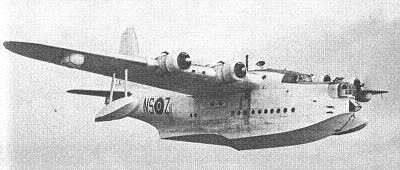![]() The Pacific War Online Encyclopedia
The Pacific War Online Encyclopedia
|
| Previous: Sunagawa Kaneo | Table of Contents | Next: Sung Hsi-lien |

Short Sunderland Mark III
| Crew | 10 to 13 | ||
| Dimensions | 112'10" by 85'4" by 32'11" 34.39m by 26.01m by 10.03m |
||
| Weight | 31,000-45,000 lbs 14,000-20,000 kg |
||
| Maximum speed | 210 mph at 6500 feet 338 km/h at 2000 meters |
||
| Cruise speed | 178 mph 286 km/h |
||
| Climb rate | 12 feet per second 3.7 meters per second |
||
| Service ceiling | 16,000 feet 4900 meters |
||
| Power plant | 4 1065 hp (794 kW) Bristol Pegasus XVIII nine-cylinder radials driving three bladed propellers. | ||
| Armament | 4 0.303 machine guns in
nose 4 0.303 machine guns in tail 2 0.303 machine guns in dorsal turret 2 0.303 machine guns in waist positions |
||
| External stores | 2000 lbs (910 kg) bombs, mines, or depth charges | ||
| Range | 1780 miles (2860 km) normal 2900 miles (4670 km) maximum |
||
| Production | 749 by Short and Blackburn from 1937: 90 Mk.I 43 Mk.II 462 Mk.III 154 Mk.V |
||
| Variants | The Mk.I had upper beam
hatches rather than a turret. Some Mk.III were fitted with ASV Mark II radar and rockets. The Mk.V had superior 1200 hp (890 kW) R-1830-90 Twin Wasp engines. |
||
The Sunderland was developed from the civilian "Empire" flying boat of
the 1930s. It
was used against U-boats
and as a transport, and
was nicknamed the "Flying Porcupine" for its
numerous defensive machine guns, with which it acquitted itself well
against German Ju-88s escorting
"Condor" patrol aircraft. It saw significant service in the Far
East.
The design originated with a 1933 Air Ministry
call for a new reconnaissance flying boat to replace the Short
Singapore. Chief designer Arthur Gouge completed a prototype which
first flew on 16 October 1937. Some modifications to the wings were
made and the defensive armament was increased, and the Sunderland
entered service in June 1938.
References
The Pacific War Online Encyclopedia © 2007-2010 by Kent G. Budge. Index